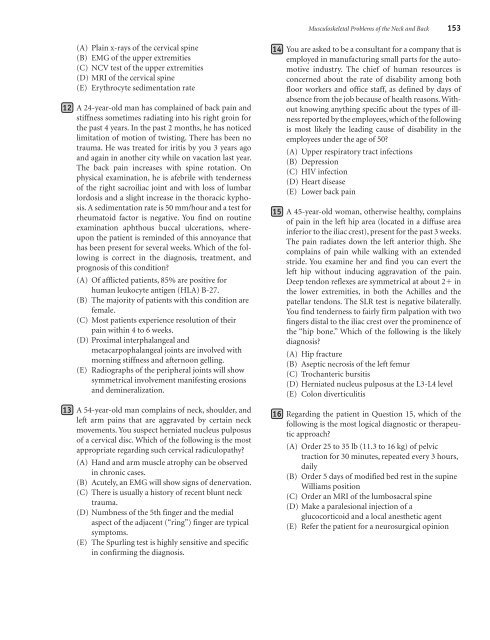NMS Q&A Family Medicine
NMS Q&A Family Medicine
NMS Q&A Family Medicine
- No tags were found...
Create successful ePaper yourself
Turn your PDF publications into a flip-book with our unique Google optimized e-Paper software.
Musculoskeletal Problems of the Neck and Back 153(A) Plain x-rays of the cervical spine(B) EMG of the upper extremities(C) NCV test of the upper extremities(D) MRI of the cervical spine(E) Erythrocyte sedimentation rate12 A 24-year-old man has complained of back pain andstiffness sometimes radiating into his right groin forthe past 4 years. In the past 2 months, he has noticedlimitation of motion of twisting. There has been notrauma. He was treated for iritis by you 3 years agoand again in another city while on vacation last year.The back pain increases with spine rotation. Onphysical examination, he is afebrile with tendernessof the right sacroiliac joint and with loss of lumbarlordosis and a slight increase in the thoracic kyphosis.A sedimentation rate is 50 mm/hour and a test forrheumatoid factor is negative. You find on routineexamination aphthous buccal ulcerations, whereuponthe patient is reminded of this annoyance thathas been present for several weeks. Which of the followingis correct in the diagnosis, treatment, andprognosis of this condition?(A) Of afflicted patients, 85% are positive forhuman leukocyte antigen (HLA) B-27.(B) The majority of patients with this condition arefemale.(C) Most patients experience resolution of theirpain within 4 to 6 weeks.(D) Proximal interphalangeal andmetacarpophalangeal joints are involved withmorning stiffness and afternoon gelling.(E) Radiographs of the peripheral joints will showsymmetrical involvement manifesting erosionsand demineralization.13 A 54-year-old man complains of neck, shoulder, andleft arm pains that are aggravated by certain neckmovements. You suspect herniated nucleus pulposusof a cervical disc. Which of the following is the mostappropriate regarding such cervical radiculopathy?(A) Hand and arm muscle atrophy can be observedin chronic cases.(B) Acutely, an EMG will show signs of denervation.(C) There is usually a history of recent blunt necktrauma.(D) Numbness of the 5th finger and the medialaspect of the adjacent (“ring”) finger are typicalsymptoms.(E) The Spurling test is highly sensitive and specificin confirming the diagnosis.14 You are asked to be a consultant for a company that isemployed in manufacturing small parts for the automotiveindustry. The chief of human resources isconcerned about the rate of disability among bothfloor workers and office staff, as defined by days ofabsence from the job because of health reasons. Withoutknowing anything specific about the types of illnessreported by the employees, which of the followingis most likely the leading cause of disability in theemployees under the age of 50?(A) Upper respiratory tract infections(B) Depression(C) HIV infection(D) Heart disease(E) Lower back pain15 A 45-year-old woman, otherwise healthy, complainsof pain in the left hip area (located in a diffuse areainferior to the iliac crest), present for the past 3 weeks.The pain radiates down the left anterior thigh. Shecomplains of pain while walking with an extendedstride. You examine her and find you can evert theleft hip without inducing aggravation of the pain.Deep tendon reflexes are symmetrical at about 2 inthe lower extremities, in both the Achilles and thepatellar tendons. The SLR test is negative bilaterally.You find tenderness to fairly firm palpation with twofingers distal to the iliac crest over the prominence ofthe “hip bone.” Which of the following is the likelydiagnosis?(A) Hip fracture(B) Aseptic necrosis of the left femur(C) Trochanteric bursitis(D) Herniated nucleus pulposus at the L3-L4 level(E) Colon diverticulitis16 Regarding the patient in Question 15, which of thefollowing is the most logical diagnostic or therapeuticapproach?(A) Order 25 to 35 lb (11.3 to 16 kg) of pelvictraction for 30 minutes, repeated every 3 hours,daily(B) Order 5 days of modified bed rest in the supineWilliams position(C) Order an MRI of the lumbosacral spine(D) Make a paralesional injection of aglucocorticoid and a local anesthetic agent(E) Refer the patient for a neurosurgical opinion
















